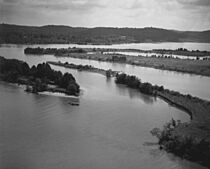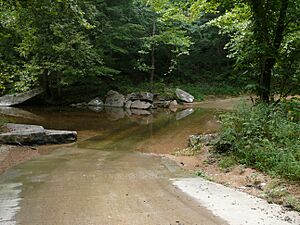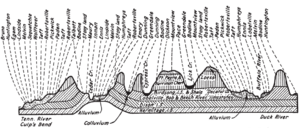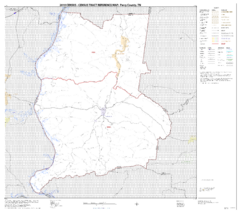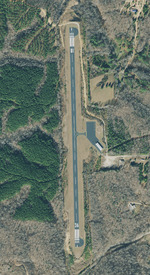Perry County, Tennessee facts for kids
Quick facts for kids
Perry County
|
|
|---|---|
|
County
|
|
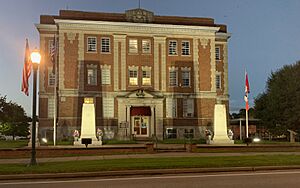
Perry County Courthouse in Linden
|
|

Location within the U.S. state of Tennessee
|
|
 Tennessee's location within the U.S. |
|
| Country | |
| State | |
| Founded | November 14, 1819 |
| Named for | Oliver Hazard Perry |
| Seat | Linden |
| Largest town | Linden |
| Other cities | Lobelville |
| Area | |
| • Total | 423 sq mi (1,100 km2) |
| • Land | 415 sq mi (1,070 km2) |
| • Water | 8.1 sq mi (21 km2) 1.9% |
| Population
(2020)
|
|
| • Total | 8,366 |
| • Density | 20.2/sq mi (7.8/km2) |
| Demonym(s) | Perry Countian |
| Time zone | UTC−6 (Central) |
| • Summer (DST) | UTC−5 (CDT) |
| ZIP Codes |
37097, 37096
|
| Area code | 931 |
| Congressional district | 7th |
| FIPS county code 47135 | |
Perry County is a county located in the U.S. state of Tennessee. As of the 2020 census, the population was 8,366, with an average population density of 20.2 persons per square mile (7.8 persons/km2), making it the least densely populated county in Tennessee. Its county seat and largest town is Linden. The county is named after American naval commander and War of 1812 hero Oliver Hazard Perry.
In 1806, the Cherokee ceded to the United States the land that would later become Perry County in the Treaty of Washington. The county was established by the Tennessee General Assembly in 1819 from parts of Wayne County, Hickman County, and Humphreys County. In 1845, the portions of Perry County located west of the Tennessee River were split off to form Decatur County.
Agriculture and forestry are the largest components of the local economy, supplemented by light industry and tourism. Perry County is one of the most economically disadvantaged counties in the state. It was severely impacted by the Great Recession of 2008, at one point having the second highest unemployment rate in the United States, and as of 2020[update] continues to lag behind the rest of the state in various economic indicators, including income inequality and poverty rates. Transportation infrastructure is limited, and no railroads, commercial airports, or freeways are present in the county.
Over 80 percent of the county is forested. The county's terrain is largely defined by its two major rivers, the Buffalo and the Tennessee, and features ridges and valleys that form tributaries to the rivers. Agriculture and outdoor recreation benefit from plentiful fresh water sources, fertile crop land, and abundant wildlife. Mousetail Landing State Park is the largest protected area in the county and a significant driver of nature tourism in the region.
Contents
History
Perry County was formed in 1819 from parts of Humphreys and Hickman counties. It is named in honor of Oliver Hazard Perry (1785–1819), American War of 1812 naval officer who, after his flagship was severely damaged, continued the fight from another ship and forced the surrender of the British fleet at the Battle of Lake Erie. Decatur County was formed from the portions of Perry County west of the Tennessee River. The first settlements in the county were along Toms Creek near the Tennessee River, with the first known birth in the area occurring in 1818. This is the first written date involving the area that would become Perry County, but it is evident that the area had some European permanent settlement prior to this. The seat of government and courts were originally located in a small town known as Harrisburg approximately 4 miles (6.4 km) south of the current seat of Linden. The county seat was transferred to its current location in Linden in 1848, where the current courthouse stands today. Harrisburg no longer exists as a municipal entity or recognized location.
Perry County was severely impacted by the economic recession of 2008 and 2009. Unemployment reached 27%, making it the highest in the state of Tennessee, and one of the highest in the United States. The massive amount of unemployment was due to the closure of a major automotive parts plant that employed a significant portion of the county's residents.
Geography and geology
Perry County is located on the western edge of Middle Tennessee. The topography of Perry County is characterized by high ridges separating creeks flowing into the county's two rivers and is typical of the Western Highland Rim region of Tennessee. The highest point in Perry County is approximately 980 feet (300 m) above sea level, located on an unnamed ridge in the far southeastern portion of the county near the borders of Lewis County and Wayne County. From its founding to 1846, the county was bifurcated by the Tennessee River. That year, the portion of the county west of the river was split off to form Decatur County, and the county took the general form it has today. Following numerous other relatively minor re-drawings, the county's borders were settled in their current positions in 1911.
Rivers
Three rivers are found within Perry County: the Tennessee River, Buffalo River, and Duck River. The Tennessee River runs along the western boundary of the county, Buffalo River bisects the county, and a bend of the Duck River crosses into the county very briefly in its far northeastern corner. Even though the county's terrain is heavily influenced by the presence of water features, there are no dams in the county registered in the National Inventory of Dams.
Tennessee River
The Tennessee River forms the western border of Perry County, dividing it from Decatur County and Benton County. It flows south to north and is navigable through the entire length of the county. In 1944, with the construction of Kentucky Dam, portions of low-lying land adjacent to the river were inundated, although the societal and environmental impact was substantially lower than areas farther downstream. While the presence of the dam allows for some level of control against regular, catastrophic flooding along the basin, the regions of the county adjacent to the river and its tributaries are listed as Special Flood Hazard Areas. The base flood elevation line ranges from 375 feet (114 m) above mean sea level in the far northwestern portion of the county, to 385 feet (117 m) above mean sea level in the far southwestern portion.
Lady's Bluff, located approximately 11 miles (18 km) west of Linden, is the tallest bluff on the lower Tennessee River, and overlooks the section of the river known as The Narrows. The river is narrow enough at this point that barges cannot pass side by side and must pass through individually. Lady's Bluff Small Wild Area is a small federally protected public access park that includes the bluff and surrounding woodland. One possibly apocryphal story of the origin of the name of the bluff stems from a supposed incident where a woman was kidnapped and used as bait for an ambush by Native Americans against white settlers encroaching on their land.
Buffalo River
The Buffalo River flows south to north through the county before entering the Duck River just north of the county line in Humphreys County, and over 25% of the river's total watershed area is within the county. The towns of Linden and Lobelville and the unincorporated communities of Flat Woods and Beardstown are located along the river. Four river outfitters are located along the river within the county and add to its value as a recreational river.
Topography and hydrography
Most of the western half of the county forms part of the watershed for the Tennessee River, while most of the eastern half drains into the Buffalo River. A very small portion of the far northeastern corner of the county drains into the Duck River. The water table is high due to the hard substrate, creating numerous springs and shallow wells, and is charged by the Highland Rim aquifer. Typical spring and well yields range from 1 to 400 gallons per minute (4.5 to 1820 liters per minute).
Buffalo Ridge bisects the county from north to south between the Tennessee and Buffalo rivers. The ridge reaches approximately 700 feet (210 m) above sea level, with a topographic prominence of about 300 feet (91 m). Eight smaller spur ridges extend to the west from the main crest of Buffalo Ridge about 9 miles (14 km), creating the drainages for nine major creeks that flow into the Tennessee River. These creeks are, from north to south, Blue Creek, Crooked Creek, Roans Creek, Toms Creek, Lick Creek, Spring Creek, Cypress Creek, Marsh Creek, and Cedar Creek. To the east of the Buffalo River, additional ridges run east to west, similar to the terrain west of Buffalo Ridge. These ridges form the basins for the main Buffalo River tributaries within the county, Coon Creek, Brush Creek, Hurricane Creek, Short Creek, and Cane Creek.
Large tracts of natural wetlands exist within the county. One estimate based on analysis of satellite photography by the Tennessee Valley Authority estimated approximately 5,200 acres (2,100 hectares) of forested wetlands and 1,200 acres (490 hectares) of non-forested wetlands. These wetlands occur primarily along stream courses, and are some of the most productive wildlife habitat in the region.
Soil and geology
Soil deposits from the three river drainages located in the county have created fertile bottomland that are used intensively for agricultural purposes. The soil profile is generally very deep, with slopes and soil types suitable for agriculture and building construction. The ridge tops are well drained and loamy, with significant chert rock deposits. Reserves of chert, sand, gravel, limestone, and phosphate can be found in the county. Cherty limestone deposits are the most extensive geologic feature of the county, and an impermeable siltstone and shale base below the chert formations has led to the emergence of numerous fresh water springs.
Blue and gray limestone outcrops are present in most valleys of the county. These limestone formations are part of the Lobelville formation of the Silurian Brownsport Group and of the Lower Helderberg Group. Significant numbers of fossils have been found in the limestone. By the late 1830s, the fossils of various newly cataloged species of mollusks and trilobites found in the county were described in reports to the General Assembly. Iron ore is extremely abundant, with numerous deposits to the west of Buffalo Ridge.
Adjacent counties
- Humphreys County (north)
- Hickman County (northeast)
- Lewis County (southeast)
- Wayne County (south)
- Decatur County (west)
- Benton County (northwest)
Weather and climate
Perry County has a humid subtropical climate (Köppen Cfa), characterized by hot, humid summers and cold winters. The average winter temperature is 47.8 °F (8.8 °C), and the average summer temperature is 75.7 °F (24.3 °C). The record low of −1 °F (−18 °C) occurred on January 24, 1963, and the record high of 105 °F (41 °C) occurred on July 17, 1980. Average seasonal snowfall is 5.5 inches (14 cm). Thunderstorms are relatively common in the county, with an average of 53 days per year seeing thunderstorm activity, usually between May and August.
National Weather Service records list sixteen tornadoes which have been reported in Perry County, with the first one recorded in 1909. Out of these, 14 were reported since 1999. The deadliest tornado recorded in the county happened on May 27, 1917, which killed five and injured an additional 67 people. Its intensity was estimated as EF/4. Perry County was also struck during the May 5, 1999, tornado outbreak. It was hit by the strongest tornado reported during the outbreak, killing three people and causing substantial damage to Linden. Another deadly tornado hit the county during the December 23, 2015, outbreak, with two killed.
| EFU | EF0 | EF1 | EF2 | EF3 | EF4 | EF5 | Total |
|---|---|---|---|---|---|---|---|
| 0 | 3 | 6 | 5 | 0 | 2 | 0 | 16 |
| Climate data for Perry County, Tennessee (1991–2020, as recorded in Linden) | |||||||||||||
|---|---|---|---|---|---|---|---|---|---|---|---|---|---|
| Month | Jan | Feb | Mar | Apr | May | Jun | Jul | Aug | Sep | Oct | Nov | Dec | Year |
| Record high °F (°C) | 76 (24) |
82 (28) |
89 (32) |
92 (33) |
96 (36) |
104 (40) |
105 (41) |
105 (41) |
101 (38) |
97 (36) |
93 (34) |
88 (31) |
105 (41) |
| Mean daily maximum °F (°C) | 48.6 (9.2) |
53.2 (11.8) |
62.6 (17.0) |
72.0 (22.2) |
78.7 (25.9) |
85.1 (29.5) |
88.7 (31.5) |
88.5 (31.4) |
83.3 (28.5) |
73.2 (22.9) |
61.4 (16.3) |
51.9 (11.1) |
70.6 (21.4) |
| Daily mean °F (°C) | 37.5 (3.1) |
41.2 (5.1) |
49.3 (9.6) |
58.1 (14.5) |
66.4 (19.1) |
74.0 (23.3) |
77.8 (25.4) |
76.9 (24.9) |
70.5 (21.4) |
59.0 (15.0) |
48.3 (9.1) |
40.7 (4.8) |
58.3 (14.6) |
| Mean daily minimum °F (°C) | 26.5 (−3.1) |
29.2 (−1.6) |
36.1 (2.3) |
44.2 (6.8) |
54.1 (12.3) |
62.9 (17.2) |
67.0 (19.4) |
65.4 (18.6) |
57.8 (14.3) |
44.9 (7.2) |
35.2 (1.8) |
29.6 (−1.3) |
46.1 (7.8) |
| Record low °F (°C) | −18 (−28) |
−10 (−23) |
6 (−14) |
19 (−7) |
30 (−1) |
36 (2) |
46 (8) |
41 (5) |
35 (2) |
21 (−6) |
6 (−14) |
−8 (−22) |
−18 (−28) |
| Average precipitation inches (mm) | 4.60 (117) |
4.91 (125) |
4.93 (125) |
5.64 (143) |
6.36 (162) |
5.31 (135) |
5.06 (129) |
3.20 (81) |
4.20 (107) |
3.82 (97) |
3.89 (99) |
5.67 (144) |
57.59 (1,463) |
| Average snowfall inches (cm) | 0.9 (2.3) |
0.7 (1.8) |
0.4 (1.0) |
0.0 (0.0) |
0.0 (0.0) |
0.0 (0.0) |
0.0 (0.0) |
0.0 (0.0) |
0.0 (0.0) |
0.0 (0.0) |
0.0 (0.0) |
0.1 (0.25) |
2.1 (5.3) |
| Average precipitation days (≥ 0.01 in) | 9.0 | 8.5 | 9.0 | 8.7 | 9.4 | 8.2 | 8.2 | 6.8 | 6.5 | 7.1 | 7.9 | 9.1 | 98.4 |
| Average snowy days (≥ 0.1 in) | 0.3 | 0.4 | 0.2 | 0.0 | 0.0 | 0.0 | 0.0 | 0.0 | 0.0 | 0.0 | 0.0 | 0.0 | 0.9 |
| Source: NOAA | |||||||||||||
Flora and fauna
About 80% of the county is wooded. Numerous species of economically important timber trees are found in the county, including white oak, walnut, black oak, hickory, and chestnut oak. 561 species of wild plants have been collected in the county. Perry County has numerous native game species, including whitetail deer, rabbit, eastern wild turkey, gray squirrel, and fox squirrel. Bobwhite quail are also present, however the population is low due to a lack of suitable habitat. Mourning dove nesting populations are typically also low, although large numbers transit the area during seasonal migrations. Common migratory waterfowl found in the county include wood duck, mallard, gadwall, Canada goose, and the Buffalo River and its tributaries are noted wood duck nesting locations. Mink, muskrat, and beaver are found throughout wetlands in the county. There are large populations of bobcat, opossum, gray fox, striped skunk, and coyote, as well as numerous species of reptiles, amphibians, and birds. Alexander Cave in the far northeastern part of the county is an important roosting and hibernation location for the endangered gray bat. Numerous fish species, including game fish such as the largemouth bass, smallmouth bass, crappie, and catfish are found in the rivers and streams of the county. The value of the large amount of game and fish found in the county was reported as early as 1932, and continues to be a major driver of tourism in the county.
The remains of prehistoric megafauna have been discovered in the county. In September 1820, the skeletal remains of a large animal, possibly a giant ground sloth (Megalonyx), were excavated in an unidentified cave in the county. The remains were reportedly recovered by a Nashville museum operator and collector, but have since been lost.
Wildlife reintroduction
By the late 1940s, fewer than 1,000 whitetail deer were found in the state, having been hunted to the brink of extirpation. In the early 1930s, the Tennessee Game and Fish Commission, the United States Forest Service, the Tennessee Valley Authority, and the United States Navy began restocking efforts on public lands in the State. In 1949, the Game and Fish Commission began their first reintroduction effort in Perry County on public lands, later expanding reintroductions to private lands in the 1950s. By the 1950s, the populations had grown large enough to sustain a limited degree of hunting. In 1960, 30 deer were harvested in the county; by 1996, that number had risen to nearly 2,200.
By the 1950s, wild turkeys had been eliminated from the county. A reintroduction and habitat management program was conducted by the Tennessee Wildlife Resources Agency (the successor agency to the Game and Fish Commission), leading to the successful return of the species to the county. While the overall number of turkeys is moderate, good local populations are found within certain areas.
Demographics
Perry County is a rural, sparsely populated county with a population of 8,366, and average density of 20.2 persons per square mile (7.8 persons/km2). It is the least densely populated county in Tennessee. Its population peaked at 8,815 in 1910 and began a steady decline through 1970. The population began growing again after 1970, with sharp increases in the 1970s and 1990s, and by 2020 it still had not surpassed the population numbers and density of the early 1900s. The county is significantly less diverse than the statewide average, with an estimated 93% of the population reporting as white versus 73.2% for the state in 2021.
| Historical population | |||
|---|---|---|---|
| Census | Pop. | %± | |
| 1820 | 2,384 | — | |
| 1830 | 7,094 | 197.6% | |
| 1840 | 7,419 | 4.6% | |
| 1850 | 5,821 | −21.5% | |
| 1860 | 6,042 | 3.8% | |
| 1870 | 6,925 | 14.6% | |
| 1880 | 7,174 | 3.6% | |
| 1890 | 7,785 | 8.5% | |
| 1900 | 8,800 | 13.0% | |
| 1910 | 8,815 | 0.2% | |
| 1920 | 7,765 | −11.9% | |
| 1930 | 7,147 | −8.0% | |
| 1940 | 7,535 | 5.4% | |
| 1950 | 6,462 | −14.2% | |
| 1960 | 5,273 | −18.4% | |
| 1970 | 5,238 | −0.7% | |
| 1980 | 6,111 | 16.7% | |
| 1990 | 6,612 | 8.2% | |
| 2000 | 7,631 | 15.4% | |
| 2010 | 7,915 | 3.7% | |
| 2020 | 8,366 | 5.7% | |
| U.S. Decennial Census 1790–1960 1900–1990 1990–2000 2010–2014 |
|||
2020 census
| Race | Number | Percentage |
|---|---|---|
| White (non-Hispanic) | 7,700 | 92.04% |
| Black or African American (non-Hispanic) | 195 | 2.33% |
| Native American | 41 | 0.49% |
| Asian | 26 | 0.31% |
| Pacific Islander | 1 | 0.01% |
| Other/Mixed | 276 | 3.3% |
| Hispanic or Latino | 127 | 1.52% |
As of the 2020 United States census, there were 8,366 people, 3,073 households, and 2,068 families residing in the county.
Economy
Agriculture makes up a significant portion of the economy of Perry County. In 2017, 287 farms were in operation, averaging 215 acres (87 hectares) each. Over 35,000 acres (14,000 hectares) of land were utilized for a variety of agricultural activities, including crop production, forestry, and pasture land. A 2018 study showed that agriculture and ag-supporting industries contributed $49.6 million to the county's economy, with 525 jobs (about 17% of total employment in the county). Over 23,000 acres (9,300 hectares), totaling about 10% of the county's area, are rated by the USDA as prime farmland. In 1999, the USDA's National Agricultural Statistics Service reported that 3,200 acres (1,300 hectares) were planted in corn, 2,600 acres (1,100 hectares) were planted in soybeans, and another 300 acres (120 hectares) were left fallow as part of a conservation program. Additional smaller acreages were planted with sorghum, snap beans, watermelons, and sweet corn. Pasture and hay production utilized nearly 30,000 acres (12,000 hectares) of farmland in the county.
Mousetail Landing State Park, the largest protected area in the county, is a significant driver of regional nature tourism. In 2021, tourist expenditures in the county totaled $5.8 million, surpassing pre-pandemic spending by $600,000. This spending generated around $200,000 in local taxes, and 54 jobs totaling about $900,000 in wages were created through tourism-related employment. The county's other accessible protected area, the TVA-managed Lady's Bluff Small Wild Area, is a small preserve on and around Lady's Bluff on the Tennessee River north of Mousetail Landing popular with nature walkers and rock climbers. A third protected area, Dry Branch State Natural Area, is partially located in the far eastern corner of the county near the border of Lewis and Hickman counties, but is not open to the public. Four river outfitters are located within the county along the Buffalo River, as well as a Boy Scouts of America operated canoe base and camp, adding to the river's economic impact.
The Perry County Chamber of Commerce and Tourism conducts marketing efforts to draw more nature-oriented tourists to the area, using the slogan "Perry County: It's Just Our Nature". In 2008, the first annual Blooming Arts Festival was held in Linden in a further attempt to increase tourism. Only one hotel operates in Perry County, the Commodore Hotel in Linden.
The earliest known bank in Perry County was organized by 1890 as the Linden Bank and Trust. It experienced a series of mergers and buyouts, and is now a branch of FirstBank. The other bank operating in the county, the Bank of Perry County, was organized in 1905 as the Bank of Lobelville. By 1975, it had opened branches in both Lobelville and Linden.
Poverty and unemployment
Perry County ranks below state and national averages in numerous economic indicators. As of 2024, Perry County was one of eight Tennessee counties listed by the Appalachian Regional Commission as a distressed county, ranking it among the bottom 10% of counties in the United States in terms of poverty rate, unemployment, and income. Perry County's Gini coefficient is .54, indicating a significantly higher level of income inequality than the rest of Tennessee. As of 2020, the gross domestic product of all industries in the county was $190 million. In 2019, the poverty rate in the county was estimated at 16.1%, three percent higher than the statewide average. The median household income was $41,034, and the per capita income was $27,970. Property values in the county are significantly below the statewide average. In 2019, the median value of owner-occupied housing was $88,100, compared to $167,200 statewide. The rate of owner-occupied housing however, was significantly higher at 82% versus the statewide average of 66%. Numerous challenges to economic expansion exist within the county, including a lack of reliable broadband internet access, no four-lane or controlled access highways, and no nearby US Department of Agriculture certified livestock meat processing.
Perry County was severely impacted by the economic recession of 2008 and 2009. Unemployment reached nearly 29%, which at the time was the highest in the state of Tennessee, and the second highest in the United States. The high unemployment rate was due to the closure of a major automotive parts plant that employed a significant portion of the county's residents. Governor Phil Bredesen made Perry County a focus of his state stimulus package in an effort to lower unemployment. Within two years, the unemployment rate was lowered to 14%, a reduction partially attributed to the governor's subsidized employment program. In 2012, an auto parts supplier opened an injection molded plastics facility in a then-shuttered factory space in Linden, providing over 400 jobs to the local community and substantially relieving unemployment in the county.
In April 2020, seasonally unadjusted unemployment peaked again at over 24%, compared to the state average of 15.6%. In 2020, a rubber parts manufacturer that was the largest employer in Lobelville shut down, significantly adding to the county's unemployment rate. As of May 2024[update], Perry County's unemployment rate had fallen to 3.6%, a decrease of 1.1% over the preceding year. Even though unemployment had fallen substantially, it was still .6% higher than the statewide average and was the 13th highest unemployment rate among Tennessee counties.
Cities and towns
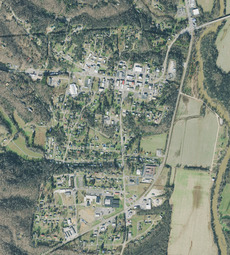
Linden, the county seat, is an incorporated town located centrally in the county, at the intersection of U.S. Route 412 and Tennessee State Route 13, to the west of where Route 412 crosses the Buffalo River. Lobelville is an incorporated city located along State Route 13 west of the Buffalo River in the northern portion of the county. In addition to the two incorporated communities, numerous unincorporated populated places are located throughout the county.
Incorporated communities by population
| Place | Population | Founded |
|---|---|---|
| Linden | 997 | 1848 |
| Lobelville | 919 | 1854 |
Unincorporated communities
- Beardstown
- Chestnut Grove
- Flat Woods
- Horner
- Pine View
- Peters Landing
- Pope
- Spring Creek
- Standing Rock
- Sugar Hill
Transportation and infrastructure
Transportation infrastructure in Perry County includes one U.S. highway, numerous state highways, and one general aviation airport. No railroads or Interstate Highways are present within the county. The Alvin C. York Bridge carries U.S. Route 412 over the Tennessee river and is the only crossing of the river in the county. Although the western border of the county is a major navigable waterway, only one small landing servicing barges is located in the county, with no major commercial port facilities or marinas. No public transportation systems or commercial scheduled passenger services of any type operate in the county. According to a 2015 study, Perry County commuters drove alone to work at the highest rate of any county in Tennessee, reflecting low access to carpooling opportunities or public transportation.
Poor transportation infrastructure has been a persistent issue in the county. One 1874 report noted the challenges to economic development brought on by a lack of rail access, paved roads, and bridges. In 1906, the lack of railroad access was again cited in regional newspapers as the limiting factor to economic growth and resource extraction.
Major highways
One federal highway, four primary state highways, and two secondary state highways transit the county. The lone federal highway, U.S. Route 412, connects Linden with the town of Parsons in Decatur County 18 miles (29 km) to the west and the town of Hohenwald in Lewis County 19 miles (31 km) to the east, with a western terminus near Dyersburg, Tennessee and eastern terminus near Columbia, Tennessee. Tennessee State Route 20 is concurrent with U.S. Route 412 through the county. Tennessee State Route 100 is also largely concurrent with U.S. Route 412, diverging from U.S. Route 412 east of Linden and entering Hickman County. The primary north-south route is Tennessee State Route 13, connecting with Interstate 40 9 miles (14 km) north of Lobelville in Humphreys County. Tennessee State Route 438 transits the northern half of the county in a general east-west orientation, connecting Centerville in Hickman County with U.S. Route 412 near the Tennessee River. Tennessee State Route 128 connects the town of Clifton in Wayne, County with State Route 13 south of Linden. Tennessee State Route 48 only briefly crosses the county's far southeast corner.
U.S. Route 412 west of Linden, and State Route 13 south of Linden are designated as Tennessee Parkways. State Route 13 and State Route 128 are both designated and signed as part of the Tennessee River Trail Scenic Byway through their entire routes in the county.
 US 412
US 412 SR 13
SR 13 SR 20
SR 20 SR 48
SR 48 SR 100
SR 100 SR 128
SR 128 SR 438
SR 438
Airports
Perry County is served by a small public general aviation airport, James Tucker Airport, constructed in 1962 south of Linden. Efforts to bring an airport to Perry County date back to 1946. A group of students from Lobelville High School petitioned the county to construct a public airport after having been introduced to aviation through the donation of a Link Trainer to the school. In addition to the public general aviation airport, a private-use helipad (FAA identifier 5TN8) is located at the now-closed Perry Community Hospital in Linden.
Pipelines
Tennessee Gas Pipeline operates a natural gas pipeline that bisects Perry County. A pumping station for the line is located in Lobelville, and was one of the largest pumping stations in the United States when it was constructed. This station and sections of the nearby pipeline are a listed EPA Superfund site. A lawsuit against the pipeline company concerning both the pipeline and the pumping station alleged the release of PCB contaminants into the local environment. As a result of this release, one study determined that those exposed suffered various neurological problems, including slowed reaction speeds and cognition problems.
Telecommunications and electric power
In 1900, Bell Telephone Company established service in the county. Lines were run from the north, diverging from the lines along the railroad in Waverly.
Typical of many rural counties, the rate of broadband internet adoption and availability remains low, with about 59% of households reporting access to broadband internet, compared to 78% statewide, as of 2020[update].
Electric power in the county is provided through Meriwether Lewis Electric Cooperative, a non-profit utility cooperative that distributes power purchased from the Tennessee Valley Authority. Many parts of the county did not have electric service until after the middle of the 20th century. Some population centers, such as the community of Flatwoods in southern Perry County, did not receive power until 1950.
Education
Perry County has one unified school district, the Perry County School System. There are four schools in the district, including one high school (Perry County High School), and three primary schools (Linden Middle School, Linden Elementary School, and Lobelville School), overseen by the Perry County Board of Education. In addition to the four in-person facilities, the county also maintains the Perry County Virtual School, a public remote-learning system for students in grades 4 through 12.
The county's first high school was opened in Linden in 1922. Prior to that, all students wishing to have an education beyond the 8th grade had to attend school outside of the county. The county's current high school, Perry County High School, was established in 1963 in Linden with the consolidation of the high schools in Linden and Lobelville. A number of parents and school administrators in Lobelville resisted the consolidation due to the distance from Linden, as well as concerns that the new school would not be ready for the beginning of the 1963 school year. In response, a special school district was granted to Lobelville by the state legislature in 1963. However, in an effort to force the consolidation to proceed, the Tennessee Board of Education ruled that the district did not qualify for any funds and would not be accredited. A group of Lobelville parents sued to keep the school district open, with volunteer teachers filling in for the 1963 school year. The case went to the Tennessee Supreme Court where it affirmed in 1964 that the State Board of Education was within its rights to deny funding to the special school district with the justification that there was an insufficient number of students in the proposed special district to justify expenditure of resources. The consolidation went forward with the Lobelville school closing later that year.
Prior to the passage of the 1964 Civil Rights Act, the county exploited loopholes in state and federal laws to prevent black children from attending high school in the county. In 1954, the county hired a local black farmer and Korean War veteran, McDonald Craig, to drive a bus to transport black children to attend high school out of the county. Using a school bus he purchased from a local Chevrolet dealer, who also happened to be descended from Craig's enslaved grandparents' owners, Craig bussed black students to Montgomery High School in Lexington, Tennessee. This bussing program lasted until the fall of 1965, when the county's schools were integrated.
The county's high school graduation rate is very high, at 97.5%, versus a statewide average of 90.4%. Approximately 75% of the population over age 25 has a high school diploma or equivalent, while 12% have a bachelor's degree or higher. Both are significantly below the statewide averages of 87% and 27%, respectively.
In 1947, the county established a board and funding for a public library. By 1986 two public libraries had been established, one in Linden and another in Lobelville.
Media and entertainment
Throughout its history, numerous radio stations and newspapers have existed in Perry County. As of 2022[update], the county is served by two radio stations, WOPC on the FM band and WMAK on the AM band. Six different newspapers are known to have been printed in the county, starting in 1880 with the Linden Times. Subsequent newspapers included the Linden Mail (1890s to 1910s), the New Age (1900s to 1920s), the Perry County News (1913 to late 1910s), and the Perry Countian (1924 to 1978). In 1976 the Buffalo River Review began publication. It merged with the Perry Countian in 1978 and continues publication weekly as the county's sole print newspaper.
Music and film
In 1928 the Weems String Band, a folk music group originating in the county, recorded with Columbia Records what is widely considered to be one of the best folk music recordings of the era. The two songs on the record are the only known works recorded by the group. The band was drawn by noted cartoonist Robert Crumb and featured in a series of trading cards done by the artist on musicians.
In 1957, the film Natchez Trace starring Zachary Scott, Marcia Henderson, and William Campbell, and directed by Alan Crosland, Jr. was filmed in the southern part of the county near Flatwoods. Numerous locals appeared as extras in the lost film which chronicled the life of John Murrell, a bandit who operated in the area in the early 19th century.
Perry County was featured in a 1992 episode of the television show Unsolved Mysteries. The episode discussed the case of George Owens, an elderly man from Nolensville, Tennessee, who disappeared on July 22, 1985. Owens was last seen in Lobelville, where he purchased ice cream and cigars from a shop. Six days after this sighting his car was found on a wooded hilltop in a remote portion of the county. He was declared legally deceased by a court in 1993.
Sports and athletics
While Perry County does not currently host any professional or semi-professional athletics teams, historically at least two semi-professional baseball organizations operated in the county. From the 1920s to the late 1940s, both Lobelville and Linden fielded teams, and baseball was considered the prime pastime for residents of the county. It was of such popularity that rivalry games on holidays would be accompanied by noted musical acts, including at least one appearance by Bill Monroe, widely considered the father of bluegrass music. Linden's team, the Owls, won at least three state baseball championships.
Perry County high school athletic teams have achieved some notability in state-wide competitions, especially in basketball. In 1955, Linden High School began a three-year streak of winning the state high school boys' basketball championship. Following Linden High School's consolidation with Lobelville High School, Perry County High School again won boys' basketball state championships in 1976, 1977, and 1997.
Notable people
- William Morgan Conder – politician
- McDonald Craig – musician
- John Allen Greer – politician
- Kelsie B. Harder – professor and onomastician (name scholar)
- Bob Harris – professional basketball player
- Kirk Haston – politician and former professional basketball player
- Clyde Milan – professional baseball player, manager, and coach with the Washington Senators
- Obediah Pickard – musician
- Thetus W. Sims – politician, member of the United States House of Representatives
- Helen Craig Smith – author and educator
See also
 In Spanish: Condado de Perry (Tennessee) para niños
In Spanish: Condado de Perry (Tennessee) para niños


